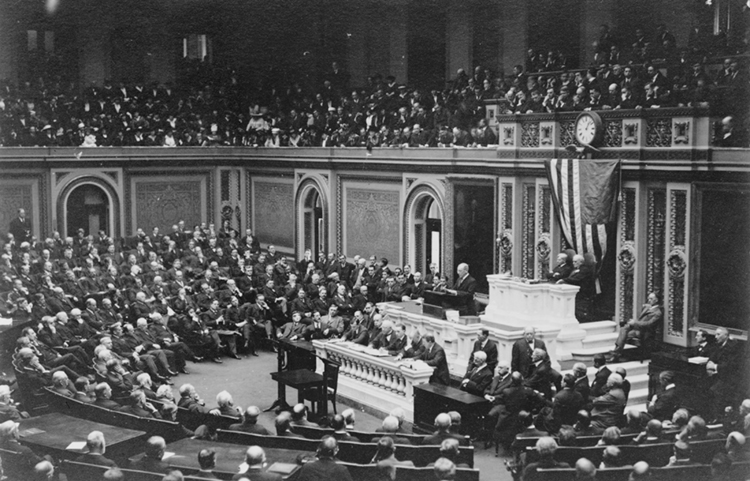Current Events Lesson Plan: April 6-12, 2017
Current Event: U.S. Enters World War I: 100 Years
April 6, 1917, marked the 100th anniversary of when the United States House of Representatives approved a resolution declaring war on Germany, entering the United States into World War I. Four days earlier, U.S. President Woodrow Wilson had asked Congress for a declaration of war, warning “the world must be made safe for democracy.” At the start of World War I, President Wilson declared the neutrality of the United States. Most Americans initially opposed U.S. involvement in a European war. However, Germany’s sinking of the Lusitania and other actions against civilians drew American sympathies to the Allies. Several events early in 1917 persuaded the U.S. government to enter the “war to end all wars.” In February, Germany returned to unrestricted submarine warfare. Tension between the United States and Germany further increased as a result of the “Zimmermann telegram.” The telegram was a message from Germany’s foreign minister, Arthur Zimmermann, to the German ambassador to Mexico. The British intercepted and decoded the message in January and relayed the message to the United States in late February. The message revealed a German plot to persuade Mexico to go to war against the United States. Wilson finally called for war, and Congress backed him up on April 6. However, the U.S. military at that time lacked experience, modern weapons, and a sufficient number of soldiers. It would be a year before enough American troops were in Europe to help the Allies defeat Germany.

President Woodrow Wilson asks Congress to declare war on Germany on April 2, 1917. Credit: Library of Congress
Objective:
World War I, sometimes called the Great War, involved more countries than any other war up to its time. The war was fought between the Allies, which included France, Russia, the United Kingdom, and the United States; and the Central Powers, which included Austria-Hungary, Germany, and the Ottoman Empire. World War I was more destructive than any previous conflict. Tens of millions of soldiers were killed or wounded. Including the flu epidemic that began at the end of the war, tens of millions of civilians died of disease, starvation, and other war-related causes. The economic chaos caused by the war helped lead to the Great Depression of the 1930’s. The “war to end all wars” failed to live up to that promise as just 21 years later, World War II (1939-1945) began. The Behind the Headlines news story and related World Book articles explore the people and battles of World War I.
Words to know:
- Congress of the United States
- House of Representatives
- Lusitania
- Spanish flu
- Submarine
- Treaty of Versailles
- Woodrow Wilson
- World War I
- Zimmermann telegram
Discussion Topics:
1. Have your students review World Book’s World War I article. Ask your students to name military and political leaders of World War I. (They might name Georges Clemenceau, David Lloyd George, Paul von Hindenburg, T. E. Lawrence [Lawrence of Arabia], Nicholas II, John J. Pershing, Baron Manfred von Richthofen [the Red Baron], Wilhelm II, Woodrow Wilson.)
2. Ask your students to name wars that have been fought since World War I, “the war to end all wars,” ended. (They might say the Afghanistan War, Bosnian War, Falklands War, Iran-Iraq War, Iraq War, Korean War, Persian Gulf War of 1991, Six-Day War, Spanish Civil War, Vietnam War, World War II.)
3. Have your students debate the topic, “When is war justified?”
4. Ask your students to use World Book’s Timelines feature to view or add to the World War I timeline. (Students may wish to use World Book’s World War I article for help)


